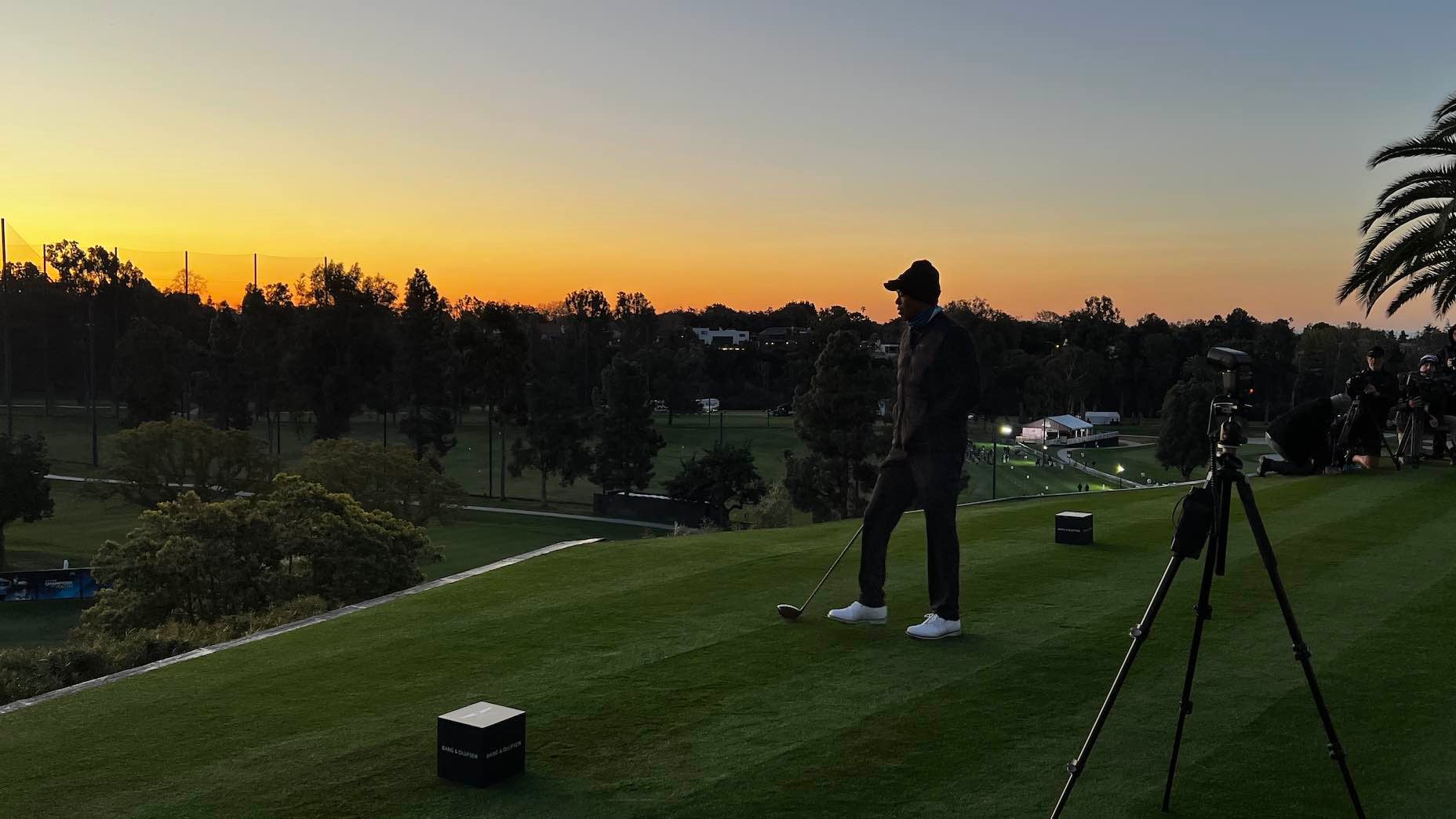There’s nothing like the golden leaderboards against a blue sky.
Sean Zak
On Sunday afternoon, as Brian Harman headed out to polish off what he had been working toward all week, I was extremely ready to leave England. The wind was up. It had been raining all day — all weekend, really — so the mud was up, too. It had also been more than a month for me in Britain, and this was how it was ending. Glamorously.
I guess that’s part of the reason why I had visited for a full month. Thirty-five days, to be exact. To make damn sure I had my day at Wimbledon and my lovely morning at Royal Birkdale and to cover the Genesis Scottish Open, which was the opposite of a blowout. I took two red-eye flights in the span of 48 hours to get from Wyndham Clark’s win at LACC to the 1st tee of Royal Liverpool.
But then I bounced from Hoylake down to London’s heathland, with a short stint in Leeds and a full week in Lothian, circling back to cover the Open in the elements. For the most part, I visited the U.K. for a second straight summer, hoping for 65-degree days, carrying the clubs, finishing rounds after 10 p.m. and…zero time on the practice range. That’s how it is over there. All part of the charm. And even if it ended in anticlimax, I felt like I was cheating the system, hand-picking a golf summer that visitors dream about. Here are nine things that have been on my mind as I finish my summer of golf back here in America.
1. The bacon
Perhaps the most contentious belief I hold is that English bacon is better than American bacon. It comes from the same animal, let’s be clear. Just a different part of the animal. Back bacon vs. streaky bacon — the former cut thicker, with a bit more fat included, in wider, more circular pieces.
It’s served with brown sauce — which Brooks Koepka really loves — and with a twinge of salt. It feels prepared rather than cooked to a crisp, its sides curling up away from the heat. English bacon layers up on a bun in a rather satisfactory way for someone who enjoys hearty breakfasts. I’m convinced a latte and a bacon roll — maybe even two, depending on how many drinks were consumed the night prior — is the perfect start to a golf day.
2. The Scousers
I spent a total of 16 days in the Liverpool area — two stints of eight days each. The 16th of those 16 days was spent at Formby Golf Club, where I made my favorite post-golf drink order one final time: Guinness and a water. The water to hydrate you. The Guinness to fill you up. A “Meal in a glass” as the Irish say.
When our foursome piled into ‘The Golfer’s Bar’ inside the clubhouse, the Guinness keg had been tapped. We had to wait, and for our pain of those 10 extra non-Guinness minutes, the hostess brought us a fresh batch of chips (French fries). As she dropped them off and turned back to the cownteh, I was immediately sad for the quickest moment. I was leaving the Scouse accent behind.
In mid-June I could barely understand these people. But after 16 days, I had grown to adore the way they drop their mid-word Rs and their end-of-word Ts. And how they seem to be clearing their throat when a word ends in K. “Perfect” to them sounds like pay-uh-fek to Americans. If you’re “busy,” you’re bezzy. Tommy-lad is Toh-mee, not Tah-mee. It’s the best.
3. The trains
On my return travel from Manchester to Chicago, I ran into some classic, Midwest summer storms. My connecting flight from New York City was canceled, and my first thought was not rebooking with Delta, or even another airline. Rather, I went straight to Amtrak. It’s comical looking back, but a month in England will convince you that trains can bring you anywhere, even quicker than cars or flights.
Perhaps this results from a very train-savvy shape, Great Britain running mostly north and south, surrounded by seas. Whatever lies in between needs to be accessible. But it feels like nothing to get from London to Edinburgh, or from Manchester to Bristol. Why is it a five-hour train between Chicago and Indianapolis, and just 3.5 to travel the same distance between Norwich and Brighton?
In Liverpool, Golf by Train is the way to live. Also, most of the Merseyside stations are complemented by a privately owned and conveniently placed coffee shop, with enough baps and flapjacks and flat whites to send you on your way.
4. The colors
There is nothing like evening golf at the Open, when a full spectrum of colors lays out in front of you. The perfect green blending into a hazy yellow grass. The navy grandstands tucked up under the golden leaderboards. For Royal Liverpool, there’s the white and auburn clubhouse, upon which forest green ivy creeps down as the season wears on. Don’t ask me why I got emotional here, but no other sporting event does natural beauty more easily than this one.
5. The roundabouts
During Genesis Scottish Open week, I was blessed with a courtesy car, the GV80 SUV, which took me off the trains and planted me firmly in the driver seat on the left side of the road. That freaks out a lot of visitors at first. It’s tricky getting a sense of where the left side of the vehicle is. The country roads of East Lothian seem to creep in from both sides. Small towns force you to thread the needle between parked cars and oncoming traffic.
But oddly, I find driving in the U.K. really enjoyable, mostly because of roundabouts. Look right and you’ll know when to go. Count the exits until you find the round one. If you miss it, just take another spin through and peel off correctly. It’s a driving mulligan, if you will. Yes, we have roundabouts in the States but a few weeks abroad will convince you we don’t have nearly enough.
6. The bunkers
When, exactly, did we get soft with bunkers? Traps, as some people like to call them. Traps of sand. Not corners you can easily wiggle out of. Pits of sand you should feel trapped in.
At some point in the game’s storied history — likely during the proliferation of clubs in every corner of America — the form of bunkers changed from devilish places that impede into cozier, flatter, more maneuverable places that might just save you rather than punish. I won’t pretend that agronomy doesn’t matter, and that different climates offer different water tables and different flora to manage, but in the endless debate of How Do We Challenge The Best In The World I feel like Royal Liverpool gave us a pretty obvious answer. Well placed bunkers make everyone uncomfortable when they’re a legitimate hazard.

Jamie Kennedy
Over the decades, as technology increased our ability to get out of bunkers, superintendents in the U.K. responded by making them deeper. They raised the faces and shrunk the surroundings. They made them more claustrophobic. Anything to make hitting into them feel like a penalty. Like you had entered a hazard. Shame on you for doing it, too. It was most apparent to me on the 16th hole at Southport and Ainsdale, on the 17th at North Berwick, and just short of the 16th green at Royal Birkdale. But also on the 10th hole at Renaissance Club during the Genesis Scottish Open, when Sam Burns caught his iron a touch thin, impaling the top revet of a fairway bunker. Shame on him! He was penalized appropriately by the bunker face and made triple bogey in haste. And though he was upset, he soldiered on because that’s what you do in links golf. It comes with the territory. (But why can’t that territory be everywhere?)
7. The RACDG
For all the pitfalls of social media, its enduring purpose has always been to connect people who might not otherwise meet. And for that, in small, perfect doses, we can be thankful. Doses like the RACDG.
The full name of this group is clever — the Royal and Ancient Company of Dishonourable Golfers — poking fun, perhaps, at the stuffier contingents who play their golf at Muirfield or under the crest of the R&A in St. Andrews. But the moniker should help explain who is involved with the RACDG — just a bunch of people who love golf in a serious way but aren’t keen for everything about it to be so darn serious.
In my limited experience — 54 holes split over two July days, 12 months apart, with the European chapter of this global golf society — RACDG members are desperate for some action, but are even more desperate for some time together, experiencing a new course on a new day with new people. That’s the simple stuff this sport does for its individuals better than most others. The Royal and Ancient Company of Dishonourable Golfers are really just…golf sickos. I’ll absolutely miss them. At least until next summer.
8. The turf
This is the land of firm turf. In January and April and August and November. The kind of turf that takes driver out of your hands and maybe 3-wood, too. That brings every bunker into play. Where you have to squint — keep squinting — until that little white ball actually stops moving out on the horizon to be sure that it’s safe.
Carnoustie was yellow in 2018. The Old Course had turned into a fitting shade of wheat in 2022. Royal Liverpool was greener than any Open in recent memory, but it was still firm. That’s the constant. The ball moves on the ground when it lands. It runs away. And if it runs into a bank, it comes back. It slips off the side of greens and trundles onto them. It asks questions that visiting golfers often don’t have the answers to. It takes time to understand that a green can be firm and slow at the same time. It takes a few rounds to realize clubbing down is the best play in this country while clubbing up is often a better choice in the States. I got comfy by week No. 5 of my 5-week trip, of course. There’s a reason pros like to visit the U.K. for two or three tournaments at a time. It takes time.
9. The golf economics
I know it’s impolite to talk money with strangers, but one of my favorite questions to ask a Brit is a simple one: How much does it cost to be a member here?
The answers make me infuriatingly jealous because they pale in comparison to their American rivals. Eight hundred pounds. One thousand pounds. Maybe £1,200 in recent years. Maybe.
You’ve probably heard it before but it bears repeating until the end of time. Most golf clubs in the U.K. don’t hide behind gates. They don’t demand exorbitant membership prices. No, they invite visitors and charge a considerable fee, which they can do because the course is that good. That’s where it starts — with a course people want to play.
The visitor fees backload the coffers allowing memberships for the locals to be priced at a minimum. Members understand it, appreciate it, and are happy to dole out part of the tee sheet to Americans thirsty for a taste of the linksland. This system is so normalized that U.K. golfers react with all their might at the idea of a £100 annual increase.
America’s private golf system, by comparison, is broken. Thirty-thousand-dollar initiation fees seem like the median rate to play your golf behind a big, iron gate. To say nothing of the annual dues, mandatory food and bev expenditures and, well, the walking-on-your-tiptoes vibe that culture tends to create.
No, not every club in America is lumped into the description above, but many are. And those that aren’t often want to be. For the second straight summer I’ve returned home to Chicago convinced my first golf club membership won’t be in Illinois, where I live, nor in Wisconsin, where I’m from. It’ll be in Fife, or East Lothian, or Angus, or Lancashire, or Kent. It’ll feel even better that way, too.




